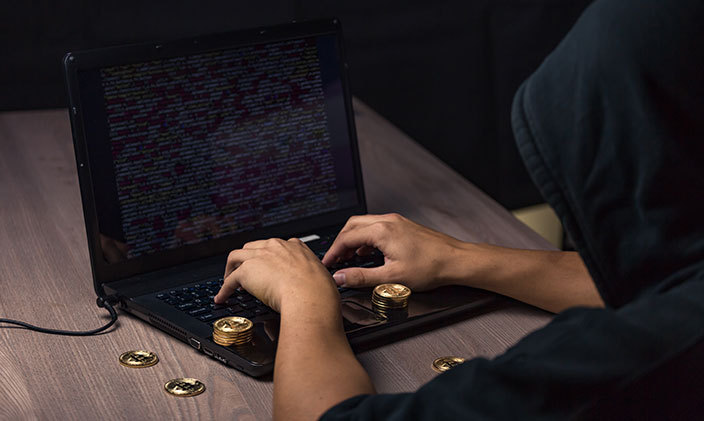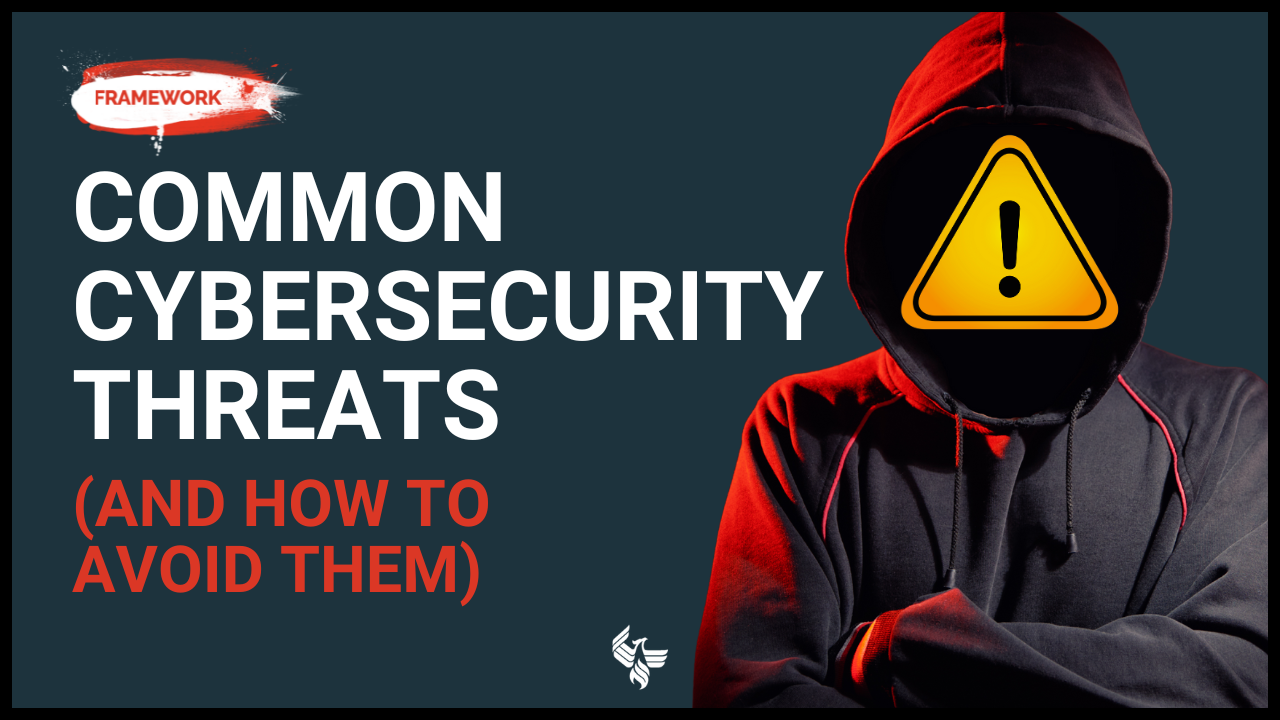Articles > Cybersecurity > What is cryptojacking and how can you avoid it?
What is cryptojacking and how can you avoid it?

Written by Michael Feder

Reviewed by Kathryn Uhles, MIS, MSP, Dean, College of Business and IT

From identity theft to stolen credit card numbers, the estimated cost of cybercrime worldwide is projected to reach $15.63 trillion by 2029. More than $51 billion of these crimes is attributed to cryptojacking. This portion of the cybercrime world includes breaches like terrorist financing, stolen funds, scams, ransomware, online pharmacy, malware, and the darknet market.
What is cryptojacking?
Cryptojacking is when a hacker secretly hijacks computers, smartphones, tablets or servers and turns them into cryptocurrency miners. The unpermitted use exploits blockchain networks or applications, which otherwise securely record and maintain cryptocurrency transactions. More than $2 billion was stolen in 2024 in just the U.S. Here’s what you need to know to prevent this type of crime.
How does cryptojacking occur?
Anyone who has a device connected to the internet and who browses webpages, checks email or downloads apps is at risk for cryptojacking.
While that sounds alarming, there are two common ways people usually fall victim. One occurs by clicking on a malicious email link, which immediately loads crypto-mining software onto your device and, unbeknownst to you, turns it into a crypto-mining machine.
The other method, called drive-by crypto-mining, happens when a piece of JavaScript code is embedded into a webpage so that any time a device is used to visit that page, the device gets used for cryptocurrency mining.
These schemes happen frequently on pages or apps that draw a lot of traffic. For example, in 2018 a cryptojacking code was found hidden on the Los Angeles Times Homicide Report page.
A year later, eight cryptojacking apps were found in the Microsoft Store and even promoted on lists of the top free apps. When users downloaded and launched one of the apps, they would unknowingly download cryptojacking software onto their device. In 2022, nearly 140 million individual crypto attacks were reported.
How to spot malicious cryptomining
Since cryptojacking occurs in the background of an operating system, it can be difficult to detect. What’s more, because the code can be disguised to look like regular processes, even antivirus and antimalware software may miss it.
One problem this cyberthreat causes also happens to be one way to detect when cryptojacking is happening: It causes your device to not function properly. A computer that’s being used to mine cryptocurrency may experience problems like:
- Decreased performance: Your device might run slower, crash often or generally offer poor performance. These are key symptoms of this type of malware code.
- Battery drain: A battery that drains faster than usual is a potential sign of crypto-malware.
- Overheating: Since malicious cryptomining is such a resource-intensive process, devices may overheat more often. Pay attention if your laptop or computer’s fan is running faster than usual.
- Central processing unit (CPU) increase: If you see an increase in CPU usage while browsing, it could mean malware software is running. Check your activity monitor or task manager, but keep in mind the scripts are likely hidden, making them harder to detect.
Recognizing the signs of cryptoattacks is only one way to protect yourself from cybercrimes. Preventing them before they happen is another.
Can cryptojacking be prevented?
Taking steps to reduce the risk of crypto-malware is also helpful for preventing other cyber threats. If there are concerns about a computer or IT system being under threat of cyberattack, consider connecting with an expert who has a background in cybersecurity and can identify the issue. IT professionals experienced in digital forensics can identify this type of malware, recover from it and prevent it and other cybercrime down the line. It’s worth the time — and a company’s security — to be proactive about understanding the impact of today’s most prominent cyberthreats.
Some helpful ways to reduce the risk of this type of malware are:
- Installing a cybersecurity program: Choose software that can detect multiple kinds of cyber threats, including crypto-malware.
- Staying updated on cryptojacking trends: Codes and scripts are constantly evolving, so take a proactive approach to understanding the essentials when it comes to technology and computers.
- Using extensions that block cryptojackers: Since crypto-malware is hidden in web browsers, install specialized browser extensions that protect devices across the web.
- Install ad blockers: Malicious cryptomining scripts can be deployed through online ads, which makes ad blockers a first line of cybercrime defense.
- Disable JavaScript: Disabling JavaScript when browsing online can help stop cryptojackers from infiltrating a device.
Keep in mind that when a computer is being victimized by this type of malware, it could also be troubled by other kinds of cyberattacks. One of the best methods of prevention is understanding other kinds of cybercrimes.
Is cryptojacking worse than other cyberattacks?
Initially, crypto-malware may seem relatively harmless, but using devices for this cybercrime is more than a breach of security — it’s also a breach of privacy and the right to sole ownership of a device. Other cybersecurity threats include:
- Phishing: Hackers pretending to be a trusted person, business or government organization send emails or texts to gain access to private information.
- Malware: Software that can disrupt IT processes or steal data and other information.
- Ransomware: A type of malware that uses encryption to ransom a victim’s private information. Critical data is encrypted so that it cannot be accessed until a ransom is paid.
- Man-in-the-middle: When hackers take over a two-party transaction to steal credit card numbers from websites.
- Stolen passwords: A cyberattack that occurs when a stolen password is used to gain access to a person’s or business’s digital information.
While this type of malware can burden a computer’s functionality, it’s not as immediately devastating as other cyberattacks, which often target financial and private information. That’s why it’s important to learn how to detect as many kinds of cyber threats as possible, including malicious cryptomining.
Learn more about preventing cryptojacking and other cybercrimes
Whether you’re seeking to gain a basic understanding of cybersecurity and other IT skills so you know more how to prevent cryptojacking, or you’re a working professional looking to expand your knowledge, University of Phoenix offers online course collections and degree programs.
- Certified Ethical Hacker Course Collection
- Computer Hacking Forensics Investigator Course Collection
- Bachelor of Science in Cybersecurity
- Bachelor of Science in Information Technology
Contact University of Phoenix for more information.

ABOUT THE AUTHOR
A graduate of Johns Hopkins University and its Writing Seminars program and winner of the Stephen A. Dixon Literary Prize, Michael Feder brings an eye for detail and a passion for research to every article he writes. His academic and professional background includes experience in marketing, content development, script writing and SEO. Today, he works as a multimedia specialist at University of Phoenix where he covers a variety of topics ranging from healthcare to IT.

ABOUT THE REVIEWER
Currently Dean of the College of Business and Information Technology, Kathryn Uhles has served University of Phoenix in a variety of roles since 2006. Prior to joining University of Phoenix, Kathryn taught fifth grade to underprivileged youth in Phoenix.
This article has been vetted by University of Phoenix's editorial advisory committee.
Read more about our editorial process.
Get your free IT Program Guide
Learn how 100% of our IT degree and certificate programs align with career-relevant skills.
Get your free IT program guide. Please enter your first and last name.
Thank you
Download your pdf guide now. Or access the link in our email.



